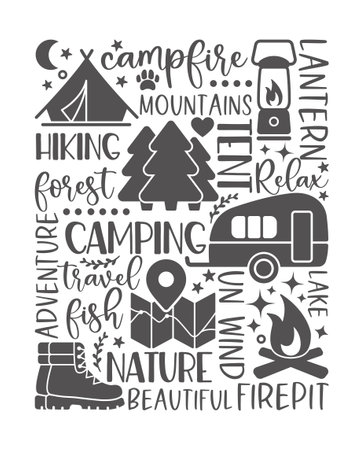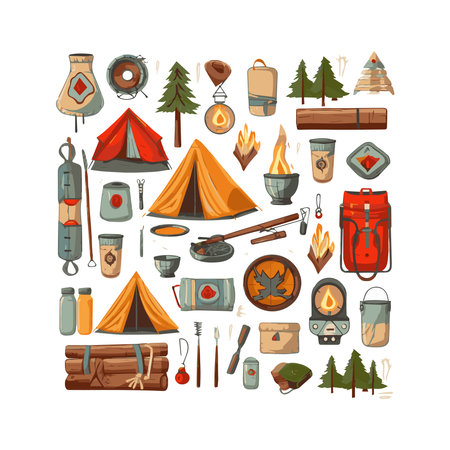1. Plan Ahead and Pack Smart
One of the most effective ways to cut down on waste during your camping trip is by planning ahead and packing smart. When you take the time to think through what you really need, you avoid overpacking and reduce the chances of bringing single-use or unnecessary items that often end up in the trash.
Make a Detailed Packing List
Before you hit the road, sit down and create a checklist of everything you’ll need for your trip. Categorize items by meals, clothing, gear, and toiletries to stay organized. This helps prevent impulse packing or grabbing last-minute disposable items like plastic utensils or paper towels.
Sample Packing List Categories:
| Category | Items to Pack |
|---|---|
| Kitchen | Reusable plates, cutlery, mugs, dish soap, cloth towels |
| Food | Pre-portioned meals, snacks in reusable containers, spices in small jars |
| Clothing | Layered clothing options, reusable laundry bag |
| Gear | Tent, sleeping bag, lanterns with rechargeable batteries |
Portion Meals Ahead of Time
Avoid food waste by prepping your meals before leaving home. Measure out ingredients into reusable containers or silicone bags so you only bring what youll actually eat. This not only reduces packaging waste but also makes cooking at camp easier and faster.
Meal Prep Tips:
- Pre-cook rice, pasta, or grains and freeze them in portions
- Use mason jars for overnight oats or salad mixes
- Bring only what you need—no more, no less
Avoid Disposable Items
Swap out single-use products for durable alternatives. Instead of paper plates, use enamelware or stainless steel dishes. Bring cloth napkins instead of paper ones. Reusable water bottles and coffee mugs are must-haves for eco-friendly campers.
Swap This → For That:
| Disposable Item | Sustainable Alternative |
|---|---|
| Plastic water bottles | Refillable stainless steel bottle |
| Paper towels | Washable cloth rags or bandanas |
| Ziploc bags | Silicone food storage bags or containers |
The better you plan before your trip, the less youll toss during it. A little preparation goes a long way in keeping nature clean and your campsite clutter-free.
2. Choose Reusables Over Disposables
One of the easiest and most effective ways to cut down on waste while camping is to bring reusable gear instead of disposable items. Not only does this reduce the amount of trash you generate, but it also saves you money in the long run and helps keep campsites cleaner for everyone.
Why Go Reusable?
Disposable products like plastic forks, paper plates, and single-use water bottles might seem convenient, but they pile up quickly—especially during a weekend camping trip. When you switch to reusables, you’re making a simple change that has a big impact on the environment.
Essential Reusables to Pack
Here’s a quick guide to some common camping items and their reusable alternatives:
| Disposable Item | Reusable Alternative |
|---|---|
| Plastic utensils | Stainless steel or bamboo cutlery set |
| Paper plates and bowls | Durable camping dishware (metal or BPA-free plastic) |
| Plastic water bottles | Refillable water bottle or hydration pack |
| Ziploc bags | Reusable silicone or fabric food storage bags |
| Packed wet wipes or napkins | Washable cloth napkins or small towels |
Tips for Success
- Create a reusable kit: Pack all your reusable items together so they’re easy to grab when you’re setting up camp or heading out for a hike.
- Clean as you go: Bring a small basin and eco-friendly soap to wash your dishes and utensils after meals.
- Add extras: Toss in an extra set of utensils or napkins in case one gets lost or dirty.
Sustainable Bonus Tip
If youre camping with friends or family, coordinate ahead of time so everyone brings their own reusables. This avoids overpacking and ensures everyone contributes to reducing waste.

3. Minimize Food Waste
Food waste is one of the biggest contributors to trash on camping trips. With a little planning, you can cut down how much food ends up in the garbage and enjoy your meals more efficiently.
Pre-Make Meals at Home
Preparing meals before you hit the road is a great way to reduce packaging and food waste. By cooking or prepping ingredients at home, you can portion out exactly what youll need and avoid bringing unnecessary items that might spoil or go uneaten.
Examples of Easy Pre-Made Camping Meals:
| Meal | Prep Tip |
|---|---|
| Chili or Stew | Cook ahead, freeze, and reheat over the campfire |
| Pasta Salad | Mix with veggies and protein, store in reusable containers |
| Breakfast Burritos | Wrap in foil for easy warming on-site |
Store Leftovers Properly
If you do end up with extra food, make sure to store it properly to avoid spoilage. Bring reusable containers with tight lids, and keep perishable foods in a well-iced cooler. Labeling containers can also help keep things organized.
Compost Food Scraps When Possible
If youre camping at a site that allows composting or if youre able to bring scraps home, compost organic waste like fruit peels, veggie trimmings, and coffee grounds instead of tossing them in the trash. This helps reduce landfill contributions and supports the environment.
Only Pack What You’ll Eat
A simple but effective strategy: don’t overpack food. Plan your meals ahead of time and stick to what you know you’ll consume. This not only reduces waste but also saves space in your cooler and cuts down on cleanup.
Quick Tips to Cut Down on Food Waste:
- Create a daily meal plan before your trip
- Avoid buying food “just in case” unless its shelf-stable snacks
- Use resealable bags or airtight containers for leftovers
- Keep perishable items cold with plenty of ice or ice packs
- If unsure about composting options, ask the campground host or check online resources before your trip
By being mindful about food preparation and storage, you’ll enjoy fresher meals, save money, and leave less behind when your adventure ends.
4. Properly Sort and Dispose of Trash
One of the easiest ways to reduce waste while camping is by sorting and disposing of trash correctly. It might seem like a small step, but it makes a big difference when youre out in nature. Being responsible with your waste is part of the “Leave No Trace” principle, which helps protect the environment for future campers.
Use Separate Bags for Different Waste
Bring at least three bags or containers to separate your waste: one for trash, one for recyclables, and one for compost (if applicable). Keeping things sorted from the start helps you stay organized and makes cleanup easier when you leave your campsite.
Recommended Setup:
| Bag Type | What to Put In |
|---|---|
| Trash | Non-recyclable packaging, broken gear, used paper towels, hygiene products |
| Recycling | Cans, plastic bottles, glass jars (make sure they’re clean) |
| Compost | Fruit peels, veggie scraps, coffee grounds (only if composting is allowed) |
Follow Local Waste Disposal Guidelines
Every campground has different rules about what can be recycled or composted. Some may offer on-site bins for sorting waste, while others require you to pack everything out. Before your trip, check the park or campground website to learn about their policies.
Pack It In, Pack It Out
If there are no disposal options on-site, make sure you take all your garbage with you. This includes micro-trash like bottle caps, twist ties, and food wrappers. Leaving no trace isn’t just about avoiding litter—its about making sure nature looks untouched after you leave.
Quick Tips:
- Label your bags so everyone in your group knows where to toss things.
- Use reusable containers instead of single-use packaging whenever possible.
- If youre backpacking, consider compressible or sealable bags to save space and avoid odors.
Sorting your waste properly helps keep campsites clean and wildlife safe. Plus, it’s a great habit that makes a positive impact every time you go outdoors.
5. Support Eco-Friendly Brands and Practices
One of the easiest ways to reduce waste on your camping trip is by supporting companies and campsites that care about the environment. When you spend your money on products and services that prioritize sustainability, youre helping build a better outdoor culture for everyone.
Buy from Sustainable Brands
Look for camping gear and supplies from companies that use minimal or recyclable packaging. Even better, choose brands that offer biodegradable or compostable products like utensils, plates, soap, and trash bags. These small changes can make a big difference in how much waste you produce at the campsite.
Eco-Friendly Product Features to Look For:
| Product Type | Eco-Friendly Feature |
|---|---|
| Dinnerware | Biodegradable or reusable (e.g., bamboo, stainless steel) |
| Toiletries | No plastic packaging, natural ingredients |
| Cleaning Supplies | Non-toxic, biodegradable formulas |
| Packing Materials | No single-use plastics, recyclable or compostable packaging |
Choose Green Campsites
Campsites that promote “Leave No Trace” values are great options when planning your trip. These sites often encourage guests to follow the “pack it in, pack it out” rule—meaning everything you bring with you should leave with you, including trash and leftovers. Some eco-friendly campgrounds even provide recycling bins, compost areas, or solar-powered facilities.
What to Look for in a Sustainable Campsite:
- Campsite promotes Leave No Trace principles
- Campsite offers recycling or composting options
- Campsite uses renewable energy sources like solar power
- Campsite discourages single-use items and encourages reusables
The more we support these kinds of practices, the more available they’ll become—and that helps protect nature for future campers too.


